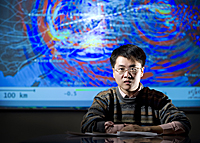ACADEMIA
UW's Chen to Use Supercomputer to Model Seismic Events to Improve Warning System
When Po Chentalks about lives lost in recent, major seismic events -- such as the 2008 earthquake in Sichuan, China, and the 2011 tsunami off the coast of Japan -- he slowly shakes his head.
"I started to study seismology as an undergraduate student in China, where there are very high seismic hazards," says Chen, a University of Wyoming School of Energy Resources associate professor of geology and geophysics . "Buildings are very poorly constructed there. When earthquakes occur, a lot of damage happens, and lots of people die."
The Sichuan quake claimed about 70,000 lives, while the Japan tsunami killed about 19,000. The Japan disaster also raised serious questions about nuclear safety in that country after damage to the Fukushima Dai-ichi nuclear plant set off a meltdown of the nuclear reactor there.
Chen is conducting research he hopes will provide precious seconds or maybe minutes to improve earthquake warning systems, which could be the difference in possibly saving thousands of lives. And the NCAR-Wyoming Supercomputing Center ( NWSC ) will play a key role in his research.
Specifically, the supercomputer will provide more detailed imaging of Chen's computer models of underground seismic activity -- imaging that may provide clues that could lead to earlier warnings of seismic activity.
State-of-the-art earthquake warning systems, such as those in Japan, currently provide information only "a few seconds" ahead of seismic events, he says. The warning time depends upon how far away you are from the epicenter, Chen says.
"If you are far away from the epicenter, you may have more time. If you are closer to the epicenter, there may be cases the strong shaking comes ahead of any warning," he explains.
"The supercomputer will give me a much better image of the underground structure to give me a better prediction of seismic waves," Chen says. "We can do our best to better prepare and understand when seismic activity is highest. For those regions with very high seismic hazards, you can build stronger buildings."
Such specific detail might have helped victims of the Japan tsunami move to higher ground earlier. While people there heard the warning sirens, they did not react quickly because they assumed the large seawall built to hold back tsunamis would, as it had in the past, be effective, Chen says.
"This time, the water wave was much higher. The wall didn't really have an effect," Chen says. "If they had this kind of (computer) accuracy, more lives may have been saved."
While a doctoral student at the University of Southern California, Chen felt a few earthquakes himself in Los Angeles. The most serious registered a fairly mild magnitude of 4.5, he says. He was luckier than some.
"One of my graduate students had family members and friends die in Sichuan (earthquake)," Chen says. "It's a realistic hazard. It motivates us to work on these programs."
To conduct his seismic earthquake research, Chen says he has received approximately $300,000 combined from the National Science Foundation (NSF), the U.S. Geological Survey and the Southern California Earthquake Center.
Detecting underground nuclear activity
Chen's research extends to other seismic activity, specifically detecting illegal underground nuclear explosions in Eastern Eurasia.
"Countries there cannot do any actual underground tests. They are banned by the Comprehensive Nuclear-Test-Ban Treaty Organization (CTBTO)," Chen says. "Our work is to help the CTBTO detect illegal nuclear explosions. If there is a test, there is a 99 percent chance it is happening underground. Nuclear tests will cause seismic activity."
China, India, Pakistan and North Korea are countries in that region that possess nuclear weapons. Of those, only China has signed the CTBTO agreement. However, China has not ratified its agreement, according to the CTBTO website.
Nuclear radiation exposure can cause leukemia, as well as breast, lung and thyroid cancer, according to the American Cancer Society. For his research in Eurasia, Chen has received $200,000.
"One of the reasons I came here (UW) was to use the supercomputer. It's very important to my own research," says Chen, who estimates his work will require 20 million core hours on the supercomputer.
To put that in perspective, imagine 20 million people working on a laptop or desk computer simultaneously for one hour.
Chen says the NWSC provides an opportunity for students to receive training in high-performance computing. Five UW graduate students are assisting Chen with his research.
The NWSC is the result of a partnership among the National Center for Atmospheric Research ( NCAR ); the University of Wyoming; the state of Wyoming; Cheyenne LEADS; the Wyoming Business Council; Cheyenne Light, Fuel and Power; and the University Corporation for Atmospheric Research. NCAR is sponsored by the National Science Foundation ( NSF ).
The NWSC will contain some of the world's most powerful supercomputers (1.6 petaflops, which is equal to 1.6 quadrillion computer operations per second) dedicated to improving scientific understanding of climate change, severe weather, air quality and other vital atmospheric science and geo-science topics. The center also will house a premier data storage (11 petabytes) and archival facility that holds irreplaceable historical climate records and other information.

